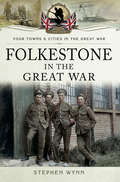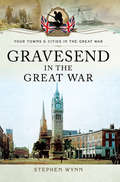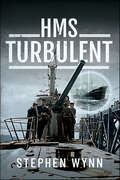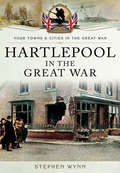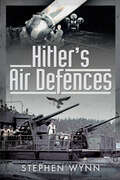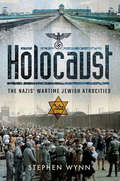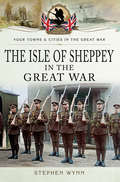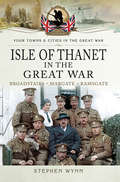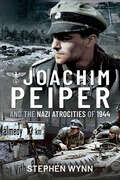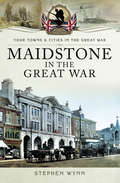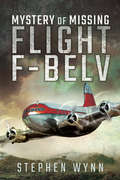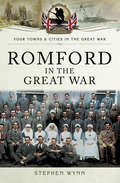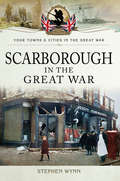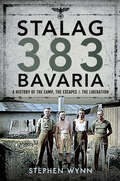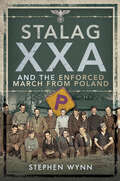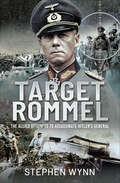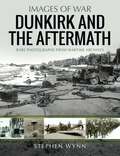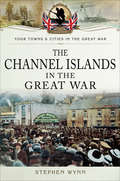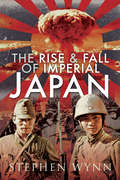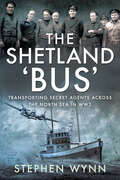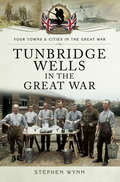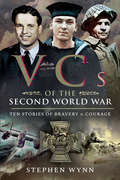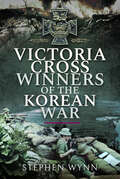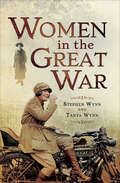- Table View
- List View
Folkestone in the Great War (Your Towns & Cities in the Great War)
by Stephen WynnFolkestone became one of the most important British towns during the First World War. Through its harbor, an estimated 10 million troops and nurses either departed from or arrived back in England between 1914 and 1919. For those leaving it was, for the most part, to fight on the battlefields of the Western Front. For those returning, it was either because they had been wounded or that they were coming home for some well-earned leave.Because of its geographical location along the south coast, the town was always going to be heavily involved in the course of the war. Shorncliffe camp saw the arrival of Canadian soldiers, infantry who had come to practice in its purpose-built trenches, and cavalry units who put their horses through their paces on its open grounds. As well as this, there was an influx of Belgian refugees who arrived in the town, having escaped the tyranny of an advancing Germany Army. Most stayed for the duration of the war, enjoying the hospitality and friendship of local people who had taken them in with open arms.With the town being a hive of military activity, the people of Folkestone went about their business as best they could. For many this included worrying about the well-being of a loved one who had gone off to fight in the war, hoping that they would remain safe but not knowing if they would ever see them again. It wasn't just on the Western Front, however, that death reared its ugly head. On one occasion it happened in Folkestone, in what has become known as the Tontines Street Air Raid. Seventy-one men, women and children were killed and another ninety-four were injured this German air raid, which took place on 25 May 1917. This book is a poignant testimony to those people as well as the men who didn't make it back
Gravesend in the Great War (Your Towns & Cities in the Great War)
by Stephen WynnGravesend was like most other towns in the UK during the course of the First World War. When the call came to serve King and Country, local men enlisted in their thousands, but sadly not all of them returned.This book gives an insight into the Tilbury to Gravesend Pontoon Bridge, which allowed the rapid deployment of troops in the event of a German invasion along the East Coast. It provided a quicker route to get troops, equipment and supplies from Essex into Kent for transportation across to France. It looks at the role both New Tavern and Shornemead Fort, part of the London Defence system, played in preventing the German Navy from carrying out direct attacks on London.There is an account of the Gravesend riots, in which groups of local people burnt and looted premises they believed belonged to German aliens who were residents in the town, and the unique story of Captain Robert Campbell, taken as a prisoner by the Germans early in the war. He was allowed home by the Kaiser to see his dying mother one last time, and voluntarily returned to captivity in Germany, on his word of honour to do so.The story of Sir Gilbert Parker, the wartime MP for Gravesend, is also told. He was instrumental in convincing America to join the war as a British Allie, which was no easy task, as the United States Justice Department estimated there were some 480,000 Germans living in America at the time.The book also tells the individual stories of Gravesend's men who fought in the war, some who survived and returned to their loved ones, and others who were not so fortunate. It documents the triumphs and tragedies of Gravesend's people as they sought to find normality amongst a reality far removed from anything they had ever known before.
HMS Turbulent
by Stephen WynnHMS Turbulent was a Royal Navy T-class submarine. From its launch in May 1941 to when it was lost at sea, along with its entire crew, in March 1943, it was responsible for the sinking of nearly 100,000 tons of enemy shipping. Besides the number of enemy vessels it sunk, HMS Turbulent has gone down in history for the attack on the Italian merchant vessel the Nino Bixio, which at the time was carrying more than 3,000 Allied POWs who had been captured during the fighting in North Africa. Having left the Libyan port of Benghazi on 16 August 1942, accompanied by the Italian cargo vessel the Sestriere, the Nino Bixio was attacked the following day. A total of 336 Allied POWs, most of whom were either Australian or New Zealanders, were killed or died of their wounds in the explosion. Although badly damaged, the Nino Bixio stayed afloat and was towed to Navarino, in southern Greece, where the surviving POWs disembarked. The wounded were treated in hospital, while the rest were shipped on to POW camps in Bari, Italy. Although there have been different theories put forward as to how HMS Turbulent met its end off the Italian coast in 1943, there is still no absolute certainty as to where, when and how the boat and its crew were lost.
Hartlepool in the Great War (Your Towns & Cities in the Great War)
by Stephen WynnWith the outbreak of the First World War, it was not surprising that a number of individuals who were of German decent, and who lived in Hartlepool and its surrounding areas, were rounded up and detained by the British military authorities, in the interests of both national security and for their own personal safety. They were held at the towns Stranton Ice Rink. Their numbers included the ex-German Consul for the Hartlepool's district as well as others who had been local residents of many years standing.The first soldier with connections to Hartlepool to be killed on foreign soil during the war, was Corporal 57561 John Robert Richardson, who was serving with the 54th Battery, Royal Field Artillery, when he was killed in action on 4 October 1914. He is buried at the Bergen Communal Cemetery at Mons.The war came to Hartlepool on the morning of Wednesday, 16 December 1914 in the shape of three vessels of the Imperial German Navy. By the time their attack was over, more than 1,100 artillery shells had landed on the town, killing 9 soldiers, 86 civilians and wounding a further 438. Amongst the dead was 29 year old Private 18/295 Theophilus Jones of the 18th Battalion, Durham Light Infantry, making him the first British serviceman to be killed on British soil as a result of enemy action during the course of the First World War. Before the war was over, his brother Alfred, would also be killed, during fighting at the Battle of Arras, on 3 May 1917.By the time the war had ended, some 1700 men and women from Hartlepool and its surrounding areas had paid the ultimate price of having served their King and country.
Hitler's Air Defences
by Stephen WynnThe first Allied bombing raid on Berlin during the course of the Second World War, took place on 7 June 1940, when a French naval aircraft dropped 8 bombs on the German capital, but the first British raid on German soil took place on the night of 10/11 May 1940, when RAF aircraft attacked Dortmund. Initially, Nazi Germany hadn't given much thought about its aerial defences. being attacked in its 'own back yard' wasn't something that was anticipated to be an issue. Germany had been on the offensive from the beginning of the war and Hitler believed that the Luftwaffe was the much stronger air force. In addition, from 1939-1942, the Allied policy of aerial attacks on German soil was to hit targets with a distinct military purpose, such as munitions factories, airfields etc. This meant that the Germany military could focus where they placed their anti-aircraft batteries and had a very good idea of how many they would need. However, Germany's defensive capabilities were forced to improve as Allied raids on towns and cities increased in size and frequency. Fighter aircraft were included as part of anti-aircraft defences and flak units mastered the art of keeping attacking Allied aircraft at a specific height. This made it more difficult for them to identify their specific targets, and easier for German fighter aircraft to shoot them down before they could jettison their bomb loads. With the Allied tactic of ‘area bombing’, Germany's anti-aircraft capabilities became harder to maintain as demand increased. The longer the war went on, along with the increased Allied bombing raids, sometimes involving more than 1,000 bomber aircraft, so the worth and effectiveness of German air-defences dwindled.
Holocaust: The Nazis' Wartime Jewish Atrocities
by Stephen Wynn“Trace[s] the developing Holocaust from the Odessa Massacre . . . a very good point to start into understanding this terrible genocide.” —FiretrenchIn Holocaust, Stephen Wynn looks at the build up to the Second World War, from the time of Hitler’s appointment as Chancellor of Germany in January 1933, as the Nazi Party rose to power in a country that was still struggling to recover politically, socially and financially from the aftermath of the First World War, while at the same time, through the enactment of a number of laws, making life extremely difficult for German Jews. Some saw the dangers ahead for Jews in Germany and did their best to get out, some managed to do so, but millions more did not. The book then moves on to look at a wartime Nazi Germany and how the dislike of the Jews had gone from painting the star of David on shop windows, to their mass murder in the thousands of concentration camps that were scattered throughout Germany. As well as the camps, it looks at some of those who were culpable for the atrocities that were carried out in the name of Nazism. Not all those who were murdered lost their lives in concentration camps. Some were killed in massacres, some in ghettos and some by the feared and hated Einsatzgruppen.“Historical studies like Holocaust: The Nazis’ Wartime Jewish Atrocities are increasingly necessary to remind present and future generations of what can happen when the forces of bigotry and racially motivated hatred goes unchecked in even the most civilized of nations.” —Midwest Book Review
Isle of Sheppey in the Great War (Your Towns And Cities In The Great War Ser.)
by Stephen WynnThe Isle of Sheppey, although not a heavily populated area, played an extremely important part in Great Britains war effort on the home front throughout the four and a half years of the First World War. In doing so, Sheppey provided protection for the Thames Estuary, the River Medway and the naval shipyards at both Sheerness and Chatham. Its defensive emplacements largely responsible for acquiring the nickname locally of the 'Barbed Wire Island.'One of its main claims to fame in relation to the years of the First World War would have undoubtedly been in relation to aviation. The island had been a hive of activity in relation to flying since the beginning of the twentieth century, when the Royal Aero Club came to Leysdown, making it the first airfield in England. What became Eastchurch Aerodrome was where the first pilots of the Royal Naval Air Service were trained, making it the first military flying school in the country. The Short brothers also had an aircraft factory at Eastchurch where they designed and built their own aircraft, some of which would be used during the First World War.The Isle of Sheppey also boasted another aircraft factory, which was situated at Shellbeach on the east coast of the island, an emergency landing strip at Harty on the south east side of the island, and a balloon station at Sheerness.The First World War certainly saw the Isle of Sheppey rise to the occasion and add to its long and illustrious military history. The part it played went a long way in enhancing the islands reputation of having a dogged determination to do what needed to be done for the greater good in the nations time of need.
Isle of Thanet in the Great War: Broadstairs—Margate—Ramsgate (Your Towns And Cities In The Great War Ser.)
by Stephen WynnBecause of the geographical location of the Isle of Thanet, it was always going to play a part in the First World War. For some wounded British and Commonwealth troops returning from the fighting in France and Belgium, it was their first sight of England in months. The Isle of Thanet just happened to be on one of the routes German Zeppelins and Gotha Bombers took on their way to try and bomb London, which meant that parts of the district were always going to be vulnerable from a sudden and unexpected attack from the air.The Isle of Thanet not only provided thousands of men for service in the armed forces, but hundreds of men and women to serve in the Voluntary Aid Detachments that were greatly needed, not just throughout the Isle of Thanet, but all over Kent, to help deal with the steady influx of returning wounded soldiers from across the English Channel.Members of local Territorial units, the 4th Battalion, The Buffs (East Kent Regiment) and the 3rd (Kent) Battalion, Royal Field Artillery, were quickly mobilized for war time service, during the early days of the war, suddenly making everything so very real for those concerned.Many of the districts Police Constables, were ex-servicemen, some of whom were still on the Army Reserve, they too were called up to once again go and serve with the colors.There was a great clamor across the country with everybody wanting to do their bit in what ever way they could, the people of the Isle of Thanet were no different. By the end of the war, they had certainly played their part in ensuring that the outcome was a victorious one, making the sadness of the ones who had paid the ultimate price, slightly easier to accept.
Joachim Peiper and the Nazi Atrocities of 1944
by Stephen WynnJoachim Peiper held the rank of Obersturmbannführer in Nazi Germany’s fanatical Schutzstaffel, more commonly referred to as the SS. He spent the first two years of the war as an adjutant to the Reichsführer of the Schutzstaffel, and leading member of the Nazi Party, Heinrich Himmler, where he would have witnessed at first hand the construction and implementation of numerous SS policies, many of which would have been in relation to ethnic cleansing and the Holocaust. In October 1941, having yearned for a chance at combat, he changed roles and became a commander in the Waffen-SS, although he still remained in regular contact with Himmler. As a member of the 1st SS Panzer Division Leibstandarte, he saw service in the Soviet Union, Italy and Belgium. On 19 September 1943, he and his men were responsible for the murder of twenty-four Italian civilians at the village of Boves. On 17 December 1944, men under his command were responsible for what became known as the Malmedy massacre, involving the murder of eighty-four unarmed American prisoners of war. Following this, between 17 and 20 December, Peiper and his men were involved in the murder of a number of other American soldiers, as well as Belgian civilians. Peiper was never charged with the atrocities at Boves, but in 1946 he faced an American military tribunal for the Malmedy masssacre. Although found guilty and sentenced to death, his sentence was reduced to life imprisonment but he was eventually released in 1956. In 1972, Peiper moved to the French village of Troves in north east France. On 14 July 1976, his home was attacked and set on fire. Overcome by smoke, he died in the flames.
Maidstone in the Great War (Your Towns & Cities in the Great War)
by Stephen WynnMaidstone in the Great War tells the remarkable story of this Kent county town's immense contribution to the Great War effort from the outbreak of war in 1914, to the long-awaited Allied victory in 1918. Maidstone has a long and illustrious military history it even had its own Civil War battle, dating back to 1648 and with the onset of the First World War, its civilians, like thousands of communities up and down the country, sent their men off to fight for their king and country. The town paid a hefty price as it lost nearly 900 of its young men. The harbinger of death catered for all strands of society, from the richest to the poorest, from those who toiled in the fields, to the loftiest of society. The book looks at the war year by year and how it directly and indirectly affected Maidstone. As more and more of its young men were killed and wounded, everyday life, or what passed for everyday life, continued the best that it could. The town's incredible support for the war on the Home Front was apparent from the very beginning. When the Mayor of Maidstone appealed to the town's people to support Lord Kitchener's request for blankets for his New Army, they responded in droves. Convalescing soldiers were tended to as passionately as Belgium refugees were looked after by the town's people; they freely and happily did this while coping with the unsettling reality that one or more of their loved ones may never return from the war. This is a superb account of the people of Maidstone's outstanding determination to see the war through.
Mystery of Missing Flight F-BELV
by Stephen WynnThe true story of the aircraft that disappeared between Saigon and Hanoi, one of the enduring mysteries of the Vietnam War.Following the Geneva Accords in 1954, Vietnam found itself separated into North and South, with communist North Vietnam under the control of Ho Chi Minh. At the same time, the International Commission for Supervision and Control (ICSC) was established, whose role it was to oversee the implementation of the Accords.On October 18, 1965, an ICSC aircraft, F-BELV, was on a regular weekly flight from Saigon to Hanoi, stopping at Phnom Penh, in Cambodia, and Vientiane, in Laos. Twenty minutes after leaving Vientiane, the captain contacted the authorities at Hanoi to give his ETA, but the aircraft never arrived. It is believed to be the only aircraft never to have been recovered from the Vietnam War.But what really happened and why? Did the aircraft crash, or was it shot down? Did it happen over Laos or North Vietnam?Mystery of Missing Flight F-BELV examines all aspects of the Vietnam War, particularly the events of 1965, and how tensions in the region heightened as the first American combat troops arrived in Vietnam. It investigates the role of the CIA, and whether their involvement had any bearing on the disappearance of F-BELV. It looks at those on board the aircraft, including James Sylvester Byrne, a sergeant in the Canadian Army and a relation to the author of this book. Was he just a regular soldier? Or was he really an intelligence officer gathering information to share with the Americans? This compelling book delves into these questions and into one of the enduring mysteries of the war.
Romford in the Great War (Your Towns And Cities In The Great War Ser.)
by Stephen WynnRomford in the Great War tells the remarkable story of Romford and its surrounding areas from the outbreak of the Great War in 1914, to the long-awaited peace of 1918. Romford had a considerable military connection during the war. The area was largely associated with the famous Sportsman's Battalions, the 23rd and 24th Battalions of the Royal Fusiliers, that, as the title suggests, was made up of well-known sportsmen of the day. Initially, the battalion stayed at Hare Hall camp in Romford and Grey Towers Camp in Hornchurch, respectively. The equally famous Artists Rifles took over Hare Hall after the Sportsman Battalion left, and went on to become a renowned officer training corps.The book takes a detailed look at the districts war memorials and rolls of honor, that commemorate the names of the local young men who answered the call to arms to protect their king and country. Wynn explores some of these names in more detail, tweaking out their individual stories of heroism, bravery and devotion to duty no matter what price they had to pay. He also offers a unique flavor of what everyday life was like for the local community, by looking through the local newspapers of the day. A growing paranoia among the masses is addressed, as are the important roles of women, who were keeping the country on top form, whether delivering mail, driving a taxi or working in a local factory, while their husbands, brothers, uncles, sons and fathers were off fighting the war. This is a superb account of the people of Romfords outstanding determination to see the war through.
Scarborough in the Great War (Your Towns And Cities In The Great War Ser.)
by Stephen WynnIn the early months of the war, for most people Scarborough was just another town somewhere in northern England, where exactly, they weren't entirely sure. But all of that changed at 8 am on the morning of 16 December 1914, when three vessels of the Imperial German Navy positioned themselves about 10 miles off of the north-eastern coastline and opened fire. The ensuing attack lasted for some 30 minutes and by the time it was over, 78 people, including women and children, had been killed and a further 228 were wounded.The disbelief at how the attack had been allowed to take place was keenly felt by the British public, and the Government were quick to turn the attack to their advantage by making it part of a propaganda campaign 'Remember Scarborough', which they used on Army recruitment posters.If it hadn't been before, the war had suddenly become a harsh reality for the entire nation, and the town of Scarborough was now well and truly on the map.After the war, the names of the hundreds of young men from the town who had been killed on a foreign battlefield, or the in the icy waters of the high seas, were commemorated on the Scarborough War Memorial at Oliver's Mount. All of these names, as well as those who had been killed in the raid of 16 December 1914, are a true testament to the price Scarborough paid for playing her part in the First World War.
Stalag 383 Bavaria: A History of the Camp, the Escapes & the Liberation
by Stephen WynnStalag 383 was somewhat unique as a Second World War prisoner of war camp. Located in a high valley surrounded by dense woodland and hills in Hofenfels, Bavaria, it began life in 1938 as a training ground for the German Army. At the outbreak of war it was commandeered by the German authorities for use as a prisoner of war camp for Allied non-commissioned officers, and given the name Oflag lllC. It was renamed Stalag 383 in November 1942. For most of its existence it comprised of some 400 huts, 30 feet long and 14 feet wide, with each typically being home to 14 men. Many of the British service men who found themselves incarcerated at the camp had been captured during the evacuations at Dunkirk, or when the Greek island of Crete fell to the Germans on 1 June 1941. Stalag 383 had somewhat of a holiday camp feel to it for many who found themselves prisoners there. There were numerous clubs formed by different regiments, or men from the same town or county. These clubs catered for interests such as education, sports, theatrical productions and debates, to name but a few. This book examines life in the camp, the escapes that were undertaken from there, and includes a selection of never before published photographs of the camp and the men who lived there, many for more than five years.
Stalag XXA Torun Enforced March from Poland
by Stephen Wynn“Based largely on a POW diary, this book sheds fresh light on the conditions facing POWs in Poland as the Nazi State collapsed . . . Very Highly Recommended.” —FiretrenchStalag XXA was a Second World War German POW camp for noncommissioned officers located in Nazi occupied Torun, in northern Poland. This book examines in detail what life was like in the camp for those held there, which over the course of the war numbered more than 60,000 men, including Polish, French, Belgians, British, Yugoslavians, Russians, Americans, Italians and Norwegians.The bulk of the book is based on a diary kept by Leonard Parker, a POW at Stalag XXA who was forced to undertake a march from the camp, commencing on January 19 1945, taking himself and his comrades to the Russian port of Odessa. It was a difficult march undertaken in harsh wintery conditions, where lack of food, the cold, and the fear of death were their constant companions. The final leg of their liberation saw the men of Stalag XXA board the Duchess of Richmond at Odessa, before arriving at Greenock, Scotland, on April 17 1945, and finally finding their freedom.“Under the format of a diary this book tells the story of Leonard Parker, his life and daily struggle of living in a prison camp . . . a great read . . . I would recommend this book to all. 5 stars.” —UK Historian
Stalag XXA Torun Enforced March from Poland
by Stephen Wynn“Based largely on a POW diary, this book sheds fresh light on the conditions facing POWs in Poland as the Nazi State collapsed . . . Very Highly Recommended.” —FiretrenchStalag XXA was a Second World War German POW camp for noncommissioned officers located in Nazi occupied Torun, in northern Poland. This book examines in detail what life was like in the camp for those held there, which over the course of the war numbered more than 60,000 men, including Polish, French, Belgians, British, Yugoslavians, Russians, Americans, Italians and Norwegians.The bulk of the book is based on a diary kept by Leonard Parker, a POW at Stalag XXA who was forced to undertake a march from the camp, commencing on January 19 1945, taking himself and his comrades to the Russian port of Odessa. It was a difficult march undertaken in harsh wintery conditions, where lack of food, the cold, and the fear of death were their constant companions. The final leg of their liberation saw the men of Stalag XXA board the Duchess of Richmond at Odessa, before arriving at Greenock, Scotland, on April 17 1945, and finally finding their freedom.“Under the format of a diary this book tells the story of Leonard Parker, his life and daily struggle of living in a prison camp . . . a great read . . . I would recommend this book to all. 5 stars.” —UK Historian
Target Rommel: The Allied Attempts to Assassinate Hitler’s General
by Stephen WynnFrom a German perspective, the highly decorated and well respected General Erwin Rommel was one of their biggest and brightest assets: a military strategist who thought ‘outside of the box’, a tactic which more than once either brought him an unexpected victory, or saved him from almost certain defeat. His reputation had been gained early in the Second World War, whilst commander of the 7th Panzer Division during the invasion of France, and as the commander of German forces during the North African campaign between 1941 and 1943. Such was his influence not only as a military strategist but on the morale of the men who served under him, as well as that of the German public, that the British government decided it needed to make concerted efforts to try to capture or eliminate him, making Rommel the only German officer of the Second World War that the allied authorities were prepared to put such time, manpower and commitment into eliminating. Two operations were put in to place to try to achieve this: Operation Flipper in November 1941, and Operation Gaff in July 1944. Both operations failed for different reasons, but just three months after the latter of the two operations, Rommel was dead, forced to commit suicide by Adolf Hitler for his part in the attempt to assassinate him on 20 July 1944. Such was the level of Rommel’s popularity and importance that the Nazi authorities reported the cause of his death to be injuries sustained in an attack on his staff car by enemy aircraft. Indeed, it was only after the war that the truth behind his death was revealed.
The Aftermath of Dunkirk: Rare Photographs from Wartime Archives (Images of War)
by Stephen WynnOperation Dynamo, the successful evacuation of Belgian, British, Dutch, French and Polish troops from the beaches at Dunkirk between 27 May and 4 June 1940, was not only a pivotal moment of the war, but one that changed its final outcome. There has been much debate in the years since the end of the war concerning the “Hitler Halt” order, which was given to German Panzer units waiting patiently on the outskirts of Dunkirk to be allowed to finish the job they had started. Many theories have been put forward as to the reasons behind this, but the consequence was that it allowed Britain to remain in the war. A total of 338,226, British and Allied troops were rescued from the beaches of Dunkirk, aboard a total of 861 vessels, of which 243 were sunk. For those left behind, official figures record that up to 80,000 French and British troops were captured, whilst during the time of the actual evacuation, somewhere in the region of 16,000 French and 1,000 British soldiers were killed. Equipment wise British forces left behind somewhere in the region of 90,000 rifles, 11,000 machine guns, huge supplies of ammunition, 880 field guns, 310 large calibre artillery pieces, 500 anti-aircraft guns, 850 anti-tank guns, 700 tanks, 45,000 cars and lorries, and 20,000 motor cycles – enough equipment to arm nearly ten divisions of soldiers. It is known that two atrocities took place during the Battle of Dunkirk: the Massacre at Le Paradis, and another at Wormhoudt, carried out by Waffen- SS soldiers, against British and French troops who had already surrendered. Although the Battle of Dunkirk must ultimately go down tactically as a German victory, the rescue of so many of its men, ensured that like a phoenix, Britain rose from the ashes of defeat to gain a great and lasting victory.
The Channel Islands in the Great War (Your Towns & Cities in the Great War)
by Stephen WynnStories of the residents of Jersey, Guernsey, and other Channel Islands and their service and sacrifice during the First World War. Before the outbreak of the First World War, the Channel Islands were scenic, sunny holiday destinations, where it was possible to briefly escape the hustle and bustle of life. But as soon as the fighting began, worries arose about the threat of a German invasion to the islands, which are much closer to the coast of France than the southern coast of Great Britain. Both men and women alike played their part. Men joined one of the islands&’ militia or enlisted in one of the numerous regiments of the British Army, including the &‘Jersey Pals&’ and the Royal Irish Fusiliers, Royal Irish Rifles, and Royal Irish Regiment. This book looks at the commitment and achievements of the Channel Islands&’ very own Royal Guernsey Light Infantry, formed in December 1916. The Islands&’ women volunteered in droves to serve with the British Red Cross&’ Voluntary Aid Detachments, not just throughout the Channel Islands, but in mainland Great Britain and further afield in Belgium, France, and beyond. Ultimately, German soldiers didn&’t set foot on the islands—except for about two thousand held captive there as prisoners of war. This book tells the story of the people of the Channel Islands and what they did during the First World War—including those who paid the ultimate price. Includes photos
The Rise & Fall of Imperial Japan
by Stephen WynnNearly a century of Japanese Imperial rule, from the 1868 Meiji Restoration to the end of WWII, is explored in this sweeping history.Under Emperor Meiji’s rule, Imperial Japan established itself as a world power through rapid industrialization and militarization. Aligned with the Entente Powers during the First World War, Japan made a proposal for racial equality at the 1919 Paris Peace Conference—only to be overruled by American President Woodrow Wilson. In the 1920s, the empire began its military conquest of numerous countries and islands throughout Asia and the Pacific regions.Author Stephen Wynn examines Japan’s various military conflicts and colonial efforts, including its invasion of China that coincided with the Second World War. The book culminates with the atomic bombs dropped on Hiroshima and Nagasaki, which finally brought about Japan’s surrender and the end of the war in Asia and the Pacific.
The Shetland 'Bus': Transporting Secret Agents Across the North Sea in WW2
by Stephen WynnA history of the World War II clandestine special operations group that linked German-occupied Norway with Scotland&’s Shetland Islands. The Shetland Bus was not a bus, but the nickname of a special operations group that set up a route across the North Sea between Norway and the Shetland Islands, north-east of mainland Scotland. The first voyage was made by Norwegian sailors to help their compatriots in occupied Norway, but soon the Secret Intelligence Service and the Special Operations Executive asked if they would be prepared to carry cargoes of British agents and equipment, as well. Fourteen boats of different sizes were originally used, and Flemington House in Shetland was commandeered as the operation&’s HQ. The first official journey was carried out by the Norwegian fishing vessel the Aksel, which left Luna Ness on 30 August 1941 on route to Bremen in Norway. This book examines that first journey, as well later ones, and discusses the agents and operations which members of the Shetland Bus were involved in throughout the war. It also looks at the donation of three submarine chasers to the operation, made in October 1943, by the United States Navy. These torpedo-type boats were 110 ft long and very fast, allowing journey times between Shetland and Norway to be greatly reduced and carried out in greater safety. The story of the Shetland Bus would be nothing without the individuals involved, both the sailors of the boats and the agents who were carried between the two countries. These were very brave individuals who helped maintain an important lifeline to the beleaguered Norwegians. It also allowed British and Norwegian agents a way into Norway so that they could liaise with the Norwegian Underground movement and carry out important missions against the German occupiers.Praise for The Shetland &‘Bus&’ &“Wynn—who has written or co-written several books on the Second World War—is to be commended for his detailed account of a captivating and understudied moment in the history of special operations. . . . Wynn&’s readable and engaging account of his subject explores the intersections of transnational, Second World War, and special operations history. As a result, it should be of interest to a wide readership.&” —The Northern Mariner &“Very highly recommended.&” —Firetrench &“A great book about individual spies and sailors from both sides of the water putting their lives at great risk. I really enjoyed this book and it was written in a bit of diary style, plenty of information and photographs. I certainly recommend this book to all.&” —UK Historian
Tunbridge Wells in the Great War (Your Towns & Cities in the Great War)
by Stephen WynnUsing original material and letters from the First World War, this captivating and eye-opening account uncovers the unnerving realities of the First World War and the impact it had on the town of Tunbridge Wells. It looks at world events, which ultimately determined the outbreak of the war, and how these same events affected the small town in Kent and the people who made up the community.From an early stage the hostilities of the war became very real for the people of Tunbridge Wells. Because of its geographical location, close proximity to major ports and rail links, the town became the headquarters of the nations Territorial Army, which brought with it 5,000 troops from all over the country.Out of nearly 3,000 people from Tunbridge Wells who enlisted in the military between 1914–1918, a staggering 801 did not return, and out of those who did, many suffered terrible wounds and injuries, both physically and mentally. Many moving stories are illustrated throughout, such as that of Private William Starks Vidler of the Royal Marines Light Infantry who became the town's first casualty of the war when his ship, HMS Amphion struck a mine and sunk. Ironically, eighteen others who died in the disaster were German sailors who had been rescued by the Amphion when their ship was sunk by the British Royal Navy.The book looks at letters sent from husbands and sons, who had seen action in the war, and how they were received by families on the Home Front, who were anxiously waiting for new of their loved ones. It documents the triumphs and tragedies of Tunbridge Wells' people as they sought to find normality amongst a reality far removed from anything they had ever known before
VCs of the Second World War: Ten Stories of Bravery & Courage
by Stephen WynnDramatic accounts of ten Victoria Cross recipients and what they did to earn this highest of honors during WWII.During the Second World War, the Victoria Cross—the highest honor to be given to British or Commonwealth forces—was awarded on 182 occasions to 181 recipients, 85 of which were bestowed posthumously.Presented here are ten examples of those who showed the utmost gallantry and bravery “in the presence of the enemy,” with each individual case and the circumstances in which the award was won examined in close detail. One example is the story of Charles Upham, 2nd Division, New Zealand Expedition Force, who was the only recipient of two Victoria Crosses: the first awarded during the Battle of Crete in 1941, and the second during fighting at El Ruweisat Ridge, Egypt, in 1942. Others include Premindra Singh Bhagat of the Indian Army, who rapidly cleared fifteen minefields despite close enemy fire and personal injury, and RAF pilot Leonard Cheshire, who received the honor after his fourth tour of duty. These and other rousing and dramatic stories are true profiles in courage.
Victoria Cross Winners of the Korean War
by Stephen WynnThe Korean War (1950-53) is often referred to by many British and Commonwealth veterans who took part in it as the 'forgotten war', a reference which does not include themselves or the families and friends of those who were killed. On 15 August 1945, US and Soviet forces liberated Korea from the Japanese and the country was subsequently divided along the 38th parallel, with the Soviets administering the northern part of the country and the Americans the south. Tensions between the two states continued, with both governments claiming to be the legitimate government of Korea. This came to a head on 25 June 1950, when the Korean People’s Army of North Korea crossed the 38th parallel into South Korea. For nearly four months the fighting swung first one way then the other, before forces from South Korea and other UN countries chased the North Koreans towards the Chinese border, which in turn saw China enter the war on the side of North Korea on 19 October. Having initially refused to send troops to Korea due to commitments in Malaya, the British government was worried about the possibility of China threatening Hong Kong, which at the time was under British control. A combination of the worsening situation in Korea, concerns about its position as a major global power, and the potential damage to its relationship with the US, caused a change of heart and, on 29 August, British forces finally arrived in South Korea. During the course of the Korean War, the Victoria Cross was awarded on just four occasions, although two other men were also awarded the equivalent George Cross. The Victoria Cross was twice awarded posthumously, with a third recipient dying in 1986 and the fourth dying in July 2018. Each of the actions which led to the awards are discussed in this book, which in the case of Bill Speakman, includes an interview he gave to the author in 2017.
Women in the Great War
by Stephen Wynn Tanya WynnA &“superlative social history&” of British women&’s efforts in WWI and how they led to the women&’s suffrage movement—includes photos (Books Monthly). In this fascinating history, husband and wife coauthors Stephen and Tanya Wynn chronicle the effects of the Great War on the lives of women, and how those experiences shaped the women&’s suffrage movement. Before the war, women were employed as domestic servants, clerical workers, shop assistants, teachers, or barmaids. But after the outbreak of World War I, women began working in munitions factories, as nurses in military hospitals, bus drivers, mechanics, and taxi drivers. They began filling jobs and social roles that had previously been reserved only for men. When the war finally came to a close, there was no going back for these determined women. Many were experiencing financial freedom for the first time and were reluctant to give up their independence. At the same time, tens of thousands of women were widowed with young children and already navigating new lives as heads of household. Chronicling the collective and individual stories of British women during the war, Women in the GreatWar demonstrates the profound and lasting impact the female war effort had on women&’s social history.
